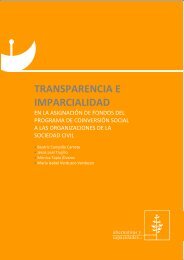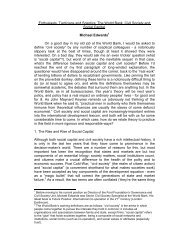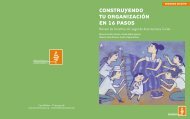'CIVIL SOCIETY AND GOVERNANCE' A CONCEPT PAPER This ...
'CIVIL SOCIETY AND GOVERNANCE' A CONCEPT PAPER This ...
'CIVIL SOCIETY AND GOVERNANCE' A CONCEPT PAPER This ...
Create successful ePaper yourself
Turn your PDF publications into a flip-book with our unique Google optimized e-Paper software.
<strong>'CIVIL</strong> <strong>SOCIETY</strong> <strong>AND</strong> <strong>GOVERNANCE'</strong>A <strong>CONCEPT</strong> <strong>PAPER</strong><strong>This</strong> paper is intended to serve as the basis for a comparative research project on civilsociety and governance, funded by the Ford Foundation, conducted by researchers in 22countries, and coordinated by the Institute of Development Studies, University ofSussex, England. It has been developed out of discussions at a workshop involvingresearchers, Foundation program officers, international co-ordinators and advisors, heldat the Institute of Development Studies in June 1998.<strong>This</strong> paper is divided into six parts. These deal with:(i) the project's aims and concepts,(ii) the more specific issues that arise when we consider civil society's actualand potential impact on governance (which we define as the manner in which acountry's public business is managed, mainly but not only by governments),(iii) the varied contexts within which civil societies operate, with a particularfocus on state/civil society relations,(iv) plans for an exercise to create maps or profiles of civil society in thevarious countries under study,(v) plans for studies of revealing cases or episodes from the recent histories ofthese countries in which civil society organizations have interacted withgovernments, and(vi) a set of concluding comments.I. AIMS <strong>AND</strong> <strong>CONCEPT</strong>SA. AimsThe idea of 'civil society' has achieved prominence in political and developmentaldiscourse over the past two decades, particularly in connection with successive wavesof democratization, beginning in Latin America and Eastern Europe, and spreadingacross the developing world. In normative terms, civil society has been widely seen asan increasingly crucial agent for limiting authoritarian government, strengtheningpopular empowerment, reducing the socially atomizing and unsettling effects of marketforces, enforcing political accountability, and improving the quality and inclusivenessof governance. Reconsideration of the limits of state action has also led to an increasedawareness of the potential role of civic organizations in the provision of public goodsand social services, either separately or in some kind of 'synergistic' relationship withstate institutions.However, general notions of 'civil society' have often been overly optimistic and havedisregarded the ambiguities and conflicts inherent in real civil societies. Moreover, the1
potentially positive impact of civil society is hard to realize in countries where states arestrong and civil organizations still weak, especially amid political conflict andeconomic decline. We need to come to a clear determination of the character and rolesof civil society, the strengths and weaknesses of civil associations in their relations withgovernance, and the ways in which they can be strengthened and their roles made morecreative.Therefore this research program has three main objectives:• To gain a clearer analytical and practical understanding of the character andfunctions of civil society, both in general and in the light of systemic and othervariations between and within regions.• While recognizing that civil organizations can play a number of potentially positiveroles, to concentrate on those activities which can enhance (or detract from) thequality of political life and governance in different societies.• To develop practical measures which can strengthen civil society and enhance itsimpact as an agent for improving political life and governance -- with particularemphasis on seeking ways to improve government policies toward poor, excludedand vulnerable groups, and to strengthen their access to and influence on the policyprocess.The second of the three points above identifies the particular 'niche' in which thisproject is situated, among the large number of recent and current studies of civil society.We focus on 'governance', a word which refers, crucially, to the sum of interactionsbetween civil society (defined below) and governments. It is thus a word which clearlyhas a relational dimension. Our main purpose is to examine how civil society andgovernments inter-relate, and how that inter-relationship might be changed in ways thatfoster better governance.We take 'good' governance to mean (in general terms) a broad array of practices whichmaximize the common/public good. More specifically, this terms refers to thefollowing things, within civil society and especially within governments: transparency,effectiveness, openness, responsiveness, and accountability; the rule of law, and theacceptance of diversity and pluralism. In all of this, we are also concerned withpractices that benefit poor and excluded groups.As civil society organizations and governments inter-relate, each side influences andaffects the other. The vectors flow in both directions. We need to examine the strengthand character of the impacts of each upon the other, as they have evolved over time.2
B. ConceptsDefinitions of 'civil society' are bewilderingly diverse and the differences between themare often rooted in alternative social and political philosophies which are hard toreconcile. However, in the context of a research project which covers a broad range ofdifferent social and political environments, it is advisable to come to some generalagreement about what we all mean by 'civil society'. How do we fashion a notion of'civil society' that can provide a precise analytical framework to guide empiricalresearch and practical action in a diversity of countries?In current analysis of civil society in poor, emergent, transitional and industrializedsocieties, one can discern two underlying understandings of the term - the political andthe sociological conceptions. The political conception of civil society is rooted in theAnglo-American tradition of liberal-democratic theory which identifies civicinstitutions and political activity as an essential component of the emergence of aparticular type of political society based on the principles of citizenship, rights,democratic representation and the rule of law. The sociological conception of civilsociety is that of an intermediate associational realm situated between the state on theone side and the basic building blocks of society on the other (individuals, families andfirms), inhabited by social organizations with some degree of autonomy and voluntaryparticipation on the part of their members.Problems arise because these two notions are often used simultaneously in confusingways. Each definition also presents our project with problems. The political definitionis often criticized for the following reasons:♦It is normatively tendentious, carrying the assumption that all societies - no matterhow diverse in cultural, social and political terms - are destined to follow the path ofliberal democratization.♦Even if one accepts that civil society is uniquely bound up with the historical processof liberal democratization, the latter idea itself has a variety of versions and inherentproblems in practice.♦If one accepts a version of this political definition and attempts to apply it to theanalysis of actual civil societies, one is led into an invidious and empirically trickytrawling exercise through different types of social organization, in an effort to decidewhich of them are truly 'civil' as opposed to those which may be dismissed as 'precivil','uncivil' or 'anti-civil'.♦The political definition is also difficult to research because it often extends beyondthe activities of concrete organizations to include broader, and more abstract, notionsof political participation and public discourse. It also tends to locate 'civil society' ina wide range of processes - informal and formal, individual and organized, sporadicand institutionalized - which make civil society hard to identify and analyze inpractice.The sociological definition, though apparently more straightforward, also presentsproblems:3
♦Are all types of intermediate association to be included -- for example, should theMafia and other such secret and criminal societies be included, or thoseorganizations which are manifestly intolerant, oppressive or violent?♦Many 'intermediate' organizations do not embody the characteristics one would wishto associate with truly civic organizations, such as autonomy and voluntaryparticipation -- or do so only partially because they are to some extent dependent onthe state or external agencies. How are these to be analyzed?♦Some influential social aggregations are informal not formal, acting as relativelystable networks between individuals or institutions. Should these be considered aspart of 'civil society'?♦Some definitions of 'intermediate' organizations include firms and households.While these may in strict terms be intermediate between the state and the individualand they may be important for analyzing certain social issues such as labor or genderrelations, should they be included under the heading of 'civil society'?♦In countries with predatory or degenerate regimes the basic rules of civic associationmay not be determined by formally constituted state authorities, and societalresponses take the form of withdrawal and non-compliance, with a focus on survivalrather than on activities aimed at improving governance. How do we accommodatethis dimension?♦Some groups and organizations that form part of civil society operate clandestinely,either because they are declared illegal, or because they suffer from systematic staterepression. In some contexts, large segments of civil society may be located in theillegal sphere. How are these to be included?For the purposes of this research program, we will use the following definition:An intermediate realm situated between state and household, populated byorganized groups or associations which are separate from the state, enjoysome autonomy in relations with the state, and are formed voluntarily bymembers of society to protect or extend their interests, values or identities. 1It is not intended that this definition should impose a strait-jacket on studies of specificsocieties. We need to be sensibly flexible in our research, as the comments belowsuggest.<strong>This</strong> definition excludes most highly informal associations of the personal networkkind, as well as families or households -- since these operate in the private sphere. Civilsociety, by contrast, operates in the public sphere. But some kinship organizationsabove the level of the nuclear or extended family (such as lineages and clans) may beimportant elements of civil society, and should be analyzed as such.1 For a more detailed discussion of these definitional issues, see Gordon White, “Civil Society,Democratization and Development (I): Clearing the Analytical Ground”, Democratization (Autumn,1994) pp. 375-390.4
The definition also excludes firms, but two comments are in order here. Certain typesof firms, such as the media and non-profit enterprises, are often important elements ofcivil society. And if firms or their leaders combine in business associations, thoseassociations should be included as elements of civil society.That last comment helps to remind us how internally diverse civil society can be. It caninclude everything from national associations of industrialists to small village-levelvoluntary associations. Studies of it therefore need to focus at national, intermediateand local levels.It could be argued that clandestine organizations should be excluded because they donot operate in full public view. But given (i) that they are important in state-societyrelations in some of the countries which we are studying, (ii) that clandestine groupscan transmogrify into associations operating in the open, and (iii) that some of them areforced to operate clandestinely by government bans, we have decided not to excludethem from this exercise.Finally, political parties present us with some difficulty. They are usually seen, withjustification, as part of civil society. But we need to be aware of two problems here.First, parties usually serve as bridges between civil society and government. Theystraddle the division between the two in ways that may undermine their loyalty andresponsiveness to civil society. And since they often exercise state power and act onthe imperatives of government, many of them are not wholly OF civil society. They canbecome involved in government efforts to control, repress, intimidate, marginalize, orcoopt civil society in ways that damage it (or parts of it). Second, some parties are soentirely the creations (and/or the creators) of governments or states (or they are sodependent upon governments) that they scarcely qualify as elements or representativesof civil society. We do not propose to exclude parties from consideration as constituentparts of civil society, but researchers in some countries will need to bear these twoproblems firmly in mind.It should be apparent from these comments that the above definition, while intended tobe practical, is itself an 'ideal-type' in the sense that the idea of 'civil society' in liberaldemocratic discourse is linked to certain intrinsic characteristics, notably voluntaryparticipation, and separation and autonomy from the state. Social organizations in thereal world only embody these characteristics to varying degrees: the boundariesbetween state and civil society are often blurred, the two organizational spheres mayoverlap and individuals may play roles in both sectors; social organizations may bepartly dependent, in terms of finance or personnel, on state or other agencies;membership in certain organizations may not be fully voluntary, and relations withinthe institutions may not be either participatory or democratic. In brief, the extent towhich a specific civic organization embodies the defining qualities of 'civil society' -separation, autonomy and voluntariness - is a question of degree rather than either/or.<strong>This</strong> sociological definition can be used to begin the research through a 'mapping' or‘profiling’ exercise which identifies the specific contours and elements of civil societyin a given country (see Part IV below). We expect such maps to be very diverse in bothsociological and political terms and to vary considerably from country to country.5
Work on civil societies in developing countries has produced the following kinds ofdistinctions between different types of civil actors: between 'modern' interest groupssuch as trade unions, professional and business associations and 'traditional'organizations based on kinship, ethnicity, culture or religion; between thoseorganizations with specifically political aspirations and roles, and those which are eitheroutside politics or only intermittently involved; between associations which accept thepolitical status quo and those which seek to transform it by changing the politicalregime or redefining the political community; between highly organized and wellresourced interest groups such as trade unions and business/professional organizationsand other forms of organization such as NGOs or community associations which havedifferent operating procedures and organizational objectives; between organizationswhich are intended to protect and extend the narrow interests of their members andthose with a wider social or political agenda; and between organizations with extensivemembership and those with quite limited membership (but sometimes with broadsupport from non-members).We thus expect the roles and activities of various civil organizations to vary widely. Wecan distinguish several distinct roles which each specific organization may or may notperform:♦representation of the interests of specific groups in relation to government and toother sectors of society;♦mobilization of social actors to increase their consciousness and impact;♦regulation and monitoring of state performance and the behaviour and actions ofpublic officials;♦developmental or social action to improve the well-being of their own or otherconstituencies.Civil organizations also vary in the nature and range of their objectives. Some of themhave explicitly 'systemic' aims in the sense that they seek to make an impact on broadpolitical and social structures and processes: for example, by changing an authoritarianinto a democratic regime; by deepening the democratic character of an existingdemocratic regime; changing socio-economic circumstances by improving equity orstimulating particular kinds of developmental action which improve the well-being ofpoor and excluded people. 2 Others may have relatively wide social aims, seeking torepresent and improve the condition of other social groups beyond their own personnelor membership. Still others may be concerned with more limited goals, seeking tomaximize the narrow interests of their own members without concern for, andsometimes at the cost of, external organizations and groups.We can also expect civil societies to vary considerably from country to country, and theethical and political character of each constellation of civil actors to be very diverse.There can be no assumption that civil society is 'virtuous' by definition or that it2 Note however, that certain civil society organizations may also act to change democratic intoauthoritarian regimes, to reduce the amount of participation in formally democratic systems and toworsen socio-economic inequalities.6
contains an intrinsic potential for contributing to better governance. 3 Nor can weassume that all civil society organizations have explicit concerns with improving thequality of political life and governance. Therefore, one of the first steps in our enquirywill be the mapping or profiling of each constellation of civil society organizations.<strong>This</strong> will involve a specific set of questions defined by the main concerns of ourresearch, i.e. the relationship between civil society and forms of governance.• What are the political orientations, objectives and activities of different civil societyorganizations?• What kinds of relations do they have with state institutions and policy processes atvarious levels of government?• What roles do they play in influencing the content of policies and nature ofgovernance in relation to alleviating poverty and assisting excluded and vulnerablegroups?• In what ways do civil society organizations provide a refuge for groups andindividuals who seek to avoid state attention through disengagement from the publicsphere?Civil society organizations can have a constructive impact on political life -- by helpingto foster fairer, more honest, transparent, democratic and accountable governance whichis more tolerant of diversity and pluralism -- in two ways. First, these organizations canappeal to governments (or even pressure them) to improve their performance in theseareas. Second, and in a more subtle manner, they can encourage these things bypracticing this sort of governance themselves, within their own organizations. <strong>This</strong> setsan example for government institutions. It also acquaints ordinary people both with thepossibility of better governance (which puts pressure on government to improve) andcan provide people with participatory experience that inculcates the skills needed tomake such governance a reality.Of course, the leaders of some civil society organizations -- representing groups whichbenefit from unfair government practices -- may not wish to see government improve inthese ways. And even leaders who might wish to see improvements in official practicesdo not always operate in this manner within their organizations.<strong>This</strong> implies the need for us to examine issues such as accountability, transparency, etc.,WITHIN civil society organizations. These organizations are often criticized -- fairly orunfairly -- by people in government for being unelected and thus unaccountable(although it is not as simple as that, since there are other ways of ensuringaccountability), and of being secretive about their finances and internal decisionmaking. <strong>This</strong> dimension needs to be explored since it will reveal how civil society isdoing less than it might in promoting good governance, and how changes in practicemight enable it to do more.3 On this point, see J.-F. Bayart, “Civil Society in Africa” in P. Chabal (ed.) Political Domination inAfrica (Cambridge, Cambridge University Press, 1986), and R. Fatton, Jr., “Africa in the Age ofDemocratization: The Civic Limitations of Civil Society”, African Studies Review (September, 1995) pp.67-99.7
II. CIVIL <strong>SOCIETY</strong> <strong>AND</strong> GOVERNANCE ISSUESThe contribution made by civil society to good governance is essentially concerned withthe means by which organized interests seek to influence and engage with stateinstitutions. In doing so, they usually help to strengthen state legitimacy and relationsof trust between public officials and ordinary citizens.As we noted above, however, not all civic organizations engage in activities designed topromote better governance. Some actively conspire to undermine good governance byaggressively pursuing self-interested goals or by fomenting violence against the state orother organized groups. Others consciously seek to evade or disengage themselvesfrom formal state structures through various forms of collective action in the informaleconomy.The contribution of civil society to good governance may be summarized under fourheadings: public policy and decision making; enhancing state performance;transparency and information; and social justice and the rule of law.A. Public Policy and Decision MakingCivil society organizations can play a role in mobilizing particular constituencies toparticipate more fully in politics and public affairs. Wealthy and socially dominantgroups are better able to organize themselves and, by virtue of superior resources andsocial status, are able to exert considerable influence over public policy. They can formand support intermediary organizations to represent and articulate their interests in aneffective manner.Poor and socially disadvantaged groups -- marginal peasants, sharecroppers, landlesslaborers, artisans, informal sector workers, urban slum dwellers, disabled people andcertain categories of women -- are usually much less able to exercise influence overpublic policy and resource allocations. Higher rates of political participation oftenresult from institutional innovations – such as democratic decentralization -- designed topromote local involvement in decision-making. But such innovations will only beeffective if grassroots organizations and social movements can organize the poor andarticulate their demands at local and higher levels.The following research questions appear to be significant here:• Under what socio-economic and political conditions can grassroots mobilization beeffective in influencing public policy?• What kinds of strategies appear to be most effective at promoting high rates of civicengagement?• What types of institutions are conducive to higher rates of political participation?8
• To what extent do public policy and resource allocations actually benefit poor andmarginalized groups?B. Transparency and InformationCivil organizations are thought to contribute to better governance by improvingtransparency and increasing the availability of information about the making andimplementation of government policy. Activities from within civil society to promotethese goals include the discovery, publication and dissemination of information aboutitems of legislation, legal provisions, public expenditure allocations, the implementationof policy and programs, and special enquiries. Such information may be directlypublished and circulated by groups within civil society, or distributed through new orexisting media outlets.These groups may also seek to mobilize citizens to pressure governments intoimplementing existing legislation and by taking action to indict public officials who areinvolved in malfeasance. Efforts to enhance transparency in government maycontribute to poverty reduction by helping citizens monitor the delivery of developmentresources and staunch the appropriation of resources by bureaucrats and local elites.<strong>This</strong> suggests a more activist role for civil society, in which civic actors back upinformation and dissemination activities with mobilization and public advocacy work.It also raises questions about the transparency and legitimacy of civic organizationswhich cannot be taken for granted.Research in this area could examine the following sets of issues:• The types of information and dissemination activities pursued by civic organizationsto further transparency and accountability;• The effectiveness of public advocacy and campaigning as means of strengtheninggovernment commitment to greater probity and responsiveness, and to implementingthe findings of special enquiries and relevant legislation and programs.C. Enhancing State PerformanceThe quality and effectiveness of public services and expenditures are integral to goodgovernance. Civil society organizations can contribute here by working directly withgovernment in shaping, financing and delivering public services in a variety of ways.These can take the form of public-private partnerships in which civil societyorganizations work closely with state institutions in designing and providing health andeducational services, by mobilizing funds from among client groups and other sources,by providing services directly, and by monitoring quality and coverage. In some casesthis can create the basis for synergy, in which state institutions acquire greaterlegitimacy and improve their performance by developing responsive working9
elationships with civil society that draw on reservoirs of social capital built up in localcommunities. 4Effective state-society partnerships arise in the context of a particular set of institutionaland political conditions which may be context-specific and not easily replicable. Theseconditions and the types of groups that can form such partnerships require more detailedcomparative investigation to determine under what circumstances synergy can befostered. The following issues are of relevance under this heading:• The nature of the policy environment and the role of the state in governing theactivities of civil society (through non-intervention, responsiveness, promotion andregulation);• The effectiveness of various types of institutional innovations designed to fostercomplementarity;• The types of leadership and forms of commitment among public officials and civicorganizations which could create mutual trust and a pre-disposition towardpartnership;• The contribution of cooperative relationships and alliance-building between civilsociety organizations and sympathetic bureaucrats to improving the quality of publicservices, and the effectiveness with which they are delivered.4 For a discussion see M. Robinson and G. White, “The Role of Civic Organisations in ServiceProvision: Towards Synergy”, Research for Action No.37 (Helsinki, WIDER, 1997).10
D. Social Justice, Rights and the Rule of LawThe fourth area where civil society can make a contribution to good governance is inthe field of social justice, rights and the rule of law. There are two main dimensions tothis:• The advocacy role of specialist human rights organizations in pressing for theimplementation of existing laws, plus fresh legislative initiatives and institutionalreforms to improve the functioning and accountability of state policing and securityorgans, and• The protective role of civil society in sheltering individuals threatened by repressivestates, defending their rights through the official legal process, for example byproviding paralegal services to groups of citizens who do not have ready access tothe courts.An array of issues bear on these matters. These include (i) the adequacy of existinglaws and of the courts and the legal profession to ensure their implementation, (ii) thepolitical realities that may impede or facilitate such efforts, and (iii) the socialenvironment which may do the same.III. BROADER CONSIDERATIONSA. ContextsWe have not as yet made extensive comments in this paper on the varied contextswithin which civic organizations have to operate. At least five contextual elements needto be considered in our research, notably the degree to which the following trends haveoccurred in each country, and the extent and character of their impacts.(i) Democratization: The spread of democratization in recent years has changed thepolitical and institutional environment in which civil society organizations operate. Insome cases civil society was the locus of active opposition to authoritariangovernments, and provided a critical breeding ground for political parties. In otherscivil society was marginalized through state repression or withdrawal from activeengagement in politics. Civil society may constitute the locus in which civic values andnorms of democratic engagement are nurtured, though conversely greater politicalfreedom can be exploited by self-interested groups to advance narrow, self-interestedagendas that can so exacerbate political conflict that it undermines governance.(ii) Reforms of political structures: Democratization has often entailed the reform ofexisting political structures or the creation of new democratic structures. <strong>This</strong> caninvolve constitutional re-design, the devolution of power to local government, andformal arrangements to widen public access to policy making. These can provide spacefor civil society organizations to engage in new activities, strengthen their interactionwith politicians and public officials, and involve larger number of people in activepolitics and government affairs.11
(iii) Institutional 'rebalancing': Challenges to the fiscal capacity of states, and doubtsabout their institutional efficacy and political character, have led to efforts to‘rebalance’ systems of social welfare provision in favor of market and civil societyorganizations. <strong>This</strong> has sometimes meant that civic organizations have taken onresponsibilities for providing social goods and public services to their ownconstituencies and wider communities, requiring a rethink of their organizationalstructures, financial base and relations with government.(iv) Economic liberalization: Economic liberalization has a number of contradictoryconsequences for civil society. In some contexts it may weaken predatory statestructures and limit the scope for rent-seeking behavior by political and bureaucraticelites. Some groups are better-placed than others to exploit the opportunities created byliberalization for advancing their own economic agendas, and organizationsrepresenting their interests can wield considerable influence over decision-making. Theremoval of price controls and other restrictions on economic activity are oftenaccompanied by the growth of the informal economy, and the emergence of a densenetwork of groups and associations geared toward the advancement of collectiveeconomic interests. The removal of safety-nets and reduction in government welfarespending gives rise to a proliferation of self-help groups and development associationswhose mandate is to provide relief and services to people marginalized or impoverishedby market reforms.(v) Globalization: The process of globalization has had an ambiguous impact on civilsociety organizations. On the one hand, like other domestic agencies such as the stateand private business, they find their autonomy compromised by invasive pressures ofglobal markets. On the other hand, globalization -- particularly in terms of freer flowsof information across national boundaries -- has fostered the spread of ‘transnationalcommunities’ and an incipient global civil society.The first two of these contextual elements (and, to a lesser degree, the third) warrantattention in this research project. The last two of the five are themes which the FordFoundation is interested in exploring in a later project on civil society.B. Analyzing State-Society RelationsThe second dimension of the broader environment concerns the approaches whichgovernments have adopted toward organized interests, and toward the possibility thatunorganized interests might emerge as active forces within civil society.Numerous strategies are available to governments – several of which can cause civilsociety to depart somewhat from the ideal type set out in our definition earlier in thispaper. In most cases, they employ a mixture of these.(i) They may adopt a laissez-faire approach, which can be rather passive, but which canalso entail efforts to encourage and enable the emergence and the activities of civilsociety organizations.(ii) They may seek to foment or reduce conflict between different sets of interests.Efforts to foment and reduce conflict are often combined -- when governmentsencourage alliances among some groups in an effort to build a coalition of support for12
themselves, while encouraging divisions between such a coalition and others whomthey regard with suspicion. They may also cultivate suspicion and division betweengroups in this latter category.(iii) They may repress all or some organized interests.(iv) They may seek to coopt some or all interests, to draw them into relationships ofdependency in order to control them – by corporatist or other means.(v) They may distribute patronage (goods, services and funds) in an effort to cultivatesome interests, in ways that may stop short of outright cooptation. Patronage systemsvary -- in their scope; in the types and amounts of resources distributed; in the degree ofcentralization within them; in the degree to which they are personalized or governed byimpersonal, institutional rules (to serve, for example, the corporate interests of a party);and in their susceptibility to profiteering by individuals within them.(vi) They may seek to mobilize all or some organized interests.(vii) They may use slogans and ideas in their approach to civil society. <strong>This</strong> may entaila political ideology, nationalistic appeals, cultural values, 'ethnic' or other forms ofidentity politics, etc.In investigating all of this, we must be aware that some governments approach theseissues with greater clarity of purpose, and with greater effectiveness than others. Weshould look out for signs of confusion, inconsistency, bungling and incapacities on thepart of governments.At least four other complications may arise:(i) In some countries, there may be more than one level of government. Regional orlocal institutions may approach civil society differently from national-level regimes.(ii) Some countries may have witnessed changes of government in recent times, oftenby means of considerable political turbulence, with attendant changes of approach tocivil society.(iii) In multi-party systems, the alternative approaches of opposition parties need to bestudied, since they often influence the approaches used by those in power. When agovernment faces no serious opposition, or no opposition at all, this also shapes theirapproaches.(iv) In some countries, we may find patchwork patterns. There may be authoritarianenclaves, regions or small centers where bosses or 'traditional' rulers (hereditarychieftains or whatever) retain great influence. We may also encounter cases in whichthe national leaders are autocratically inclined, but where more liberally-minded leadersexercise some power in pockets. <strong>This</strong> and point (i) above remind us that governmentsare not monolithic.13
We now turn to the two tasks for researchers in this initial phase of the project --described in Parts IV and V below. The FIRST task (see Part IV) is a mapping orprofiling of civil society in each of the countries being studied. We need to develop arough overall picture of the full range of civil society organizations, the roles that theyplay in relation to government, and government's posture toward them. In that exercise,researchers need to pay some attention to two types of civil society organizations: (i)those which do not contribute to better governance, and (ii) those which aim to assistpoor and socially excluded citizens. The SECOND task (see Part V) entails studies ofcases or episodes which can yield insight into the relationship between civil society andgovernment. The first of these tasks will provide us with a BREADTH ofunderstanding, while the second will provide us with analyses of greater DEPTH.IV. MAPPING OR PROFILING CIVIL <strong>SOCIETY</strong>To obtain an overview of the whole of civil society within each country, researchersshould develop a map or profile of civil society organizations. <strong>This</strong> should not be ahugely time-consuming exercise. What we want is a rough, broad sense of where civilsociety organizations are strong and weak, more active or less active, etc., to providebackground to the in-depth studies of specific cases or episodes outlined in Part Vbelow.For some countries and regions, plenty of evidence already exists to make this exercisepossible. In others, researchers will need to do some new investigations. But we do notexpect researchers to do a lot of new, primary research. Maps or profiles should berather quickly constructed, using existing studies and documents, interviews withpeople (civil society leaders, scholars, people in government, and others like journalists,lawyers, business leaders, educators, etc.) who know what is going on it their societies.Researchers should fill in the boxes on a matrix, described just below. It should coverall types of activities by civil society organizations (including activities that do notentail interactions with government), and all types of civil society organizations.Researchers should also develop a text to explain the brief entries within each box in thematrix. In the text, they should concentrate on our main concern -- the interaction ofcivil society and government.14
Down the left-hand side of the matrix, five items which describe different types of"ACTIVITIES" of civil society organizations should be listed vertically. These shouldbe:1. Representation2. Mobilization3. Regulation and Monitoring4. Developmental and Social Action5. OtherSee the discussion of the first four of these items near the end of Part I of this document.The fifth item, "Other" , is (all too obviously) for activities that do not fit within the firstfour.Across the top of the matrix, seven items, covering different "TYPES" of civil societyorganizations, should be listed horizontally, as follows:1. Social/recreational organizations 52. Interest-based (including occupational)organizations 63. Service provision organizations 74. Self-help (often community-based) organizations 85. Advocacy groups 96. Cultural/religious/'ethnic' organizations 107. Social movements (usually -- in contrast to allsix of the types above -- quite large entitieswhich may have little organization, or mayhave large memberships with an organizationat the core) 118. OthersSome organizations will fall into more than one of the categories above.The matrix is NOT something which requires detailed, exhaustive answers to all of thequestions that it poses. It is meant to be a rough guide to the condition of civil society5 These include youth clubs/teams/associations; sports/recreational associations; students' associations;associations of school/college graduates; clubs which bring together mainly urban elites (bothrecreational clubs such as country clubs or urban clubs, and 'service clubs such as Rotary).6 Small business associations; associations of largest firms, banks, etc.; professional/occupationalassociations; trade/labor union; prosperous or small farmers' associations; rural laborers' associations.7 Associations which concentrate in service provision to (large or small) social groups.8 Urban neighborhood associations; cooperative societies; savings clubs or credit unions; nongovernmentaldevelopment organizations (NGDOs) which foster self-help among small groups orcommunities; other developmentally-oriented grassroots organizations.9 Environmental associations (including those dealing with common property resources); womens'associations; issue-based pressure groups (representing children, disabled people, immigrants, etc.).10 These include religious associations; 'tribal', caste or other such associations; linguisticgroup/literary/cultural associations; associations which seek to promote the beliefs, culture or identity ofa 'primordial' group.11 Religious movements, 'ethnic' or other parochially based (linguistic, 'tribal', caste, etc.) movements;other social movements.15
in each country, which will provide context. That context will help to inform choicesabout which important issues to discuss in more depth, and which cases or episodes (seePart V) should be selected for further analysis.The text which explains the matrix for each country should provide readers with a broadintroduction to several of these issues -- by addressing these questions:‣ How and at what levels of government (national, intermediate, local) do politicalregimes impinge on civil society (see section III-B above)?‣ What are the characteristics of civil society, what types of organizations are activein what areas, and what are the limitations and the capacity of civil societyorganizations in their encounters with government?For others in the project, this will make it possible to begin comparing countries with abroad understanding of differences and similarities. Figures 1 to 4 appended to thisConcept Paper provide researchers with the types of questions, areas of concern,assessment criteria, specific indicators, and potential sources of information that couldprove useful in this exercise. But let us, here, briefly identify and comment on thesefour sets of issues.Note that for items 1 and 2 below, the information which we seek is very similar to thatwhich will be set out in the matrix discussed above. Items 3 and 4 will carryresearchers further into an analysis of state-society relations, which was discussed inPart III-B above.1. The nature and capacity of civil society organizations. Researchers are here asked toexamine the range and diversity of such organizations, their constituencies, strategies,leadership, resources, autonomy and linkages. <strong>This</strong> will enable them to enlarge, inseveral important ways, on the information provided in the matrix.2. The main activities of civil organizations. Here we seek information on activitiesaimed at promoting policy advocacy and political change. These include efforts ateducation, mobilization, encouraging political participation, forging linkages with othersuch groups, etc. <strong>This</strong> will, again, permit researchers to elaborate on information in thematrix.3. The domestic policy environment. Here we seek to understand the changes (if any)in recent times that may have affected civil society -- changes in the legal, political,regulatory or economic environment.4. The impact and effectiveness of civil society activities. Here we seek to assess thedegree to which such organizations can influence and change the policies, proceduresand character of governments.In the matrix exercise, and again in this further exercise, we need to pay specialattention to efforts by civic organizations (and indeed, the state) to assist, represent ormobilize poor and marginalized social groups. That is a crucial dimension of thisproject.16
V. STUDIES OF CASES OR EPISODESWe have agreed to follow the initial mapping or profiling exercise with a number ofstudies of revealing cases or episodes in the recent history of each country. Mappingprovides us with a greater BREADTH of understanding, while the cases or episodesprovide greater DEPTH in our analyses of important dimensions of the relationship(actual and potential) between civil society and government.Work on cases and episodes enables us to examine change over time -- over long orshort periods -- which prevents our studies from being too static. <strong>This</strong> work will alsopermit country researchers to focus on issues which are most important in theirdistinctive societies.We need to consider a diversity of cases or episodes, with the following points in mind:(a) SUCCESSES <strong>AND</strong> FAILURES: Many of our cases or episodes will naturallyprovide examples of successful encounters between civil society and government, sincewe are interested in identifying and promoting such successes. But we also need tostudy cases or episodes in which success was more limited, or which represent failures.If we compare successes with failures, we will learn more about what forces or factorsmade success possible (because they were absent when things failed) than if we studyonly successes.(b) TYPES: We should also examine different types of encounters between civilsociety and government, in at least three senses.First, we need to examine both confrontations between civil society organizations andgovernments, and less adversarial encounters -- to see how each type tends to turn outin a particular country. (Note, however, that in some countries only one of these typesof encounter is possible.)Second, we should try to ensure that the cases and episodes selected are spread fairlywidely across the matrix set out in the previous section of this paper. If they are heavilyconcentrated only in one or two boxes on the matrix, then we will not gain as widerangingan understanding of the range of encounters that can occur between civilsociety and government. (Of course, in some countries, some boxes on the matrix maybe nearly empty since few of the types of encounters represented there ever occur.)Finally, since we are especially concerned with the implications of civil society'sencounter with government for poor, excluded groups, researchers should select somecases or episodes which have such implications.(c) LEVELS: Since civil society exists at national, intermediate and local levels, it isuseful to study examples of encounters between civil society and government at variouslevels.(d) CASES INVOLVING SINGLE OR MULTIPLE CIVIL <strong>SOCIETY</strong>ORGANIZATIONS: Some cases or episodes may involve single civil society17
organizations, while others may involve several working (or trying to work) incoalitions (or, sometimes, at cross purposes).There will of course be variations on all of these fronts from country to country.Successes may be common in one place and rare in another. Certain types ofencounters will loom large in one place but not another. Crucial episodes may occurmainly at one level in one place and at another level (or at several levels) in another.Researchers will naturally consider these things when they draw up their research plans.Our plea here is simply for the inclusion of as much diversity and balance on these fourfronts as seems sensible.© James Manor26 August 199918













